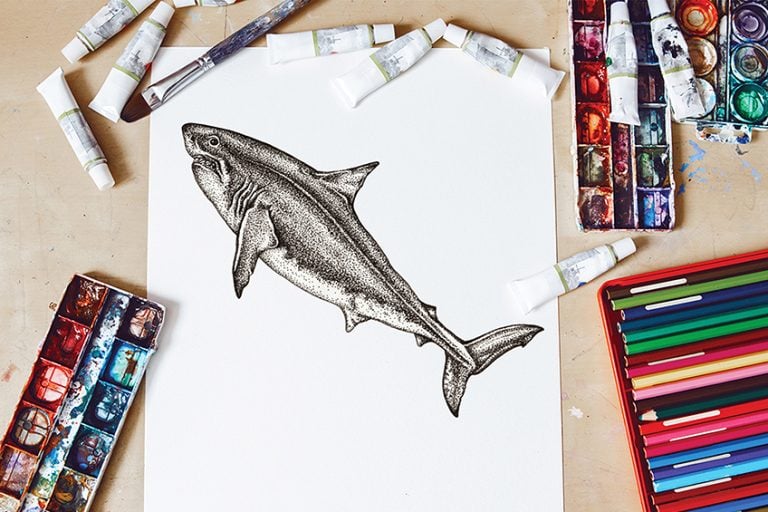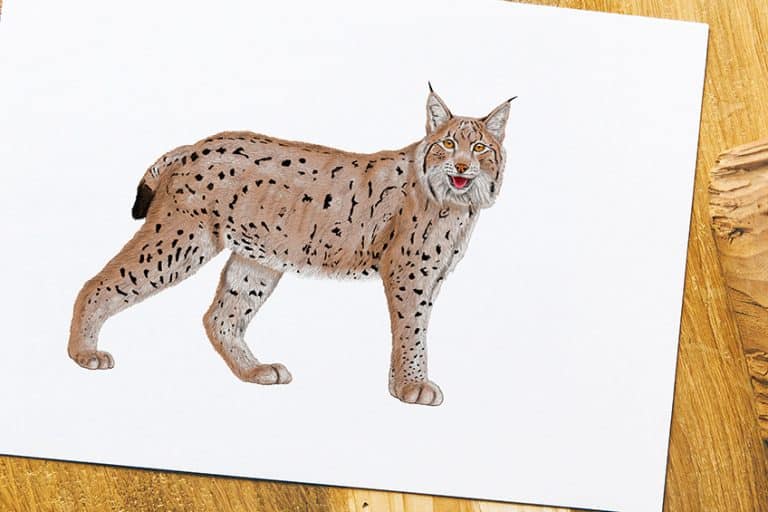How to Draw a Jellyfish – A Mystical Aquatic Drawing Tutorial
The ocean is filled with strange alien-like creatures that are unique in their own way, however, the jellyfish family is perhaps the weirdest of them all. There are also many different species of jellyfish to draw inspiration from, making it a visually rich subject. jellyfish have a very foreign physiology, with an appearance that is stranger than fiction. A jellyfish drawing is a unique animal that makes for a really fun exercise to work on shading, linework, and drawing techniques. A jellyfish drawing comes with a lot of learning curves because it is so visually different from anything in nature. This tutorial on a jellyfish illustration will give us a sense of creating unique textural qualities through the use of some interesting drawing techniques, ultimately enhancing our skills as an artist.
Table of Contents
Step-by-Step Guide on Drawing a Jellyfish
We will be creating a classic Chrysaora jellyfish drawing, as this jellyfish has a unique aesthetic providing us with a good challenge. We will start by shaping the jellyfish with a simple jellyfish sketch. We will then proceed to refine the sketch with some finer details and consolidate the jellyfish outline. Once we have done that, we will then move on to building up layers of color within our jellyfish drawing. We will work with a series of blue colors to create an aquatic-looking quality in our colored jellyfish drawing.

Step 1: Shaping the Jellyfish
We want to start simply by establishing the general shape of the jellyfish in a really simple way to capture the proportions of the features.

We want to start working on the general length of the tentacles and arms of the jellyfish. We can also make sure that they are significantly larger than the bell structure of the jellyfish.

We want to start thinking about the bowl-like shape of the hood and how the tentacles flow out from this structure like unraveling ribbons.

Try to be very loose for now, just working out the flow and shape of the jellyfish drawing. A good suggestion is to look at a reference image to assist you in the drawing process.

Step 2: Refining the Shape of the Jellyfish
We can now proceed to lightly erase our jellyfish drawing, leaving behind some light ghost lines. We want to slowly refine the drawing with layered details.
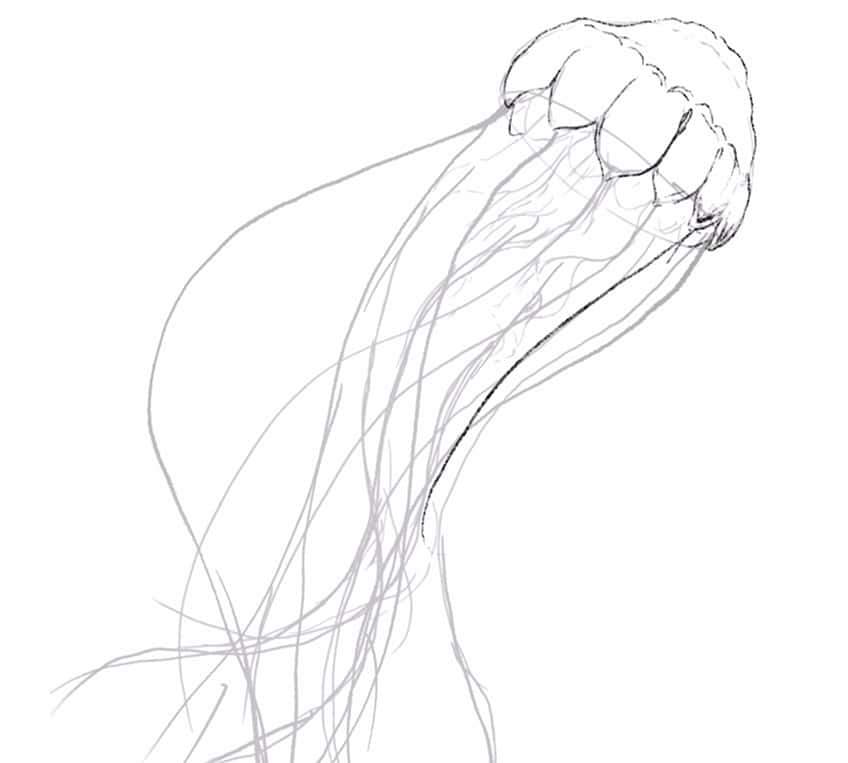
We can start giving more structure and detailed features to the bell of the jellyfish, this is where we can look at some examples of Chrysaora jellyfish for inspiration.

We want to work with this unraveling concept and maintain that feature within the tentacles of the jellyfish.

We want to make sure that we also consider the arms of the jellyfish and how they flow around the tentacles in a spiraling motion.

Once again, we can lightly erase our sketch, each time slowly bringing a more refined shape to these different features of the jellyfish.

Step 3: Adding Colored Layers
The Chryosora jellyfish often have a white translucent quality, however, we will work with a variety of blues to capture an aquatic coloration in the jellyfish.

We want to start working in some blue details to, again, refine the shape of various features but to do so this time with color.

This is where we start to consider tonal differences, depending on which areas are more exposed and less exposed to a light source.

We can also start to work on creating rides along the top surface area of the bell structure. This will bring a more nuanced quality to the jellyfish drawing.
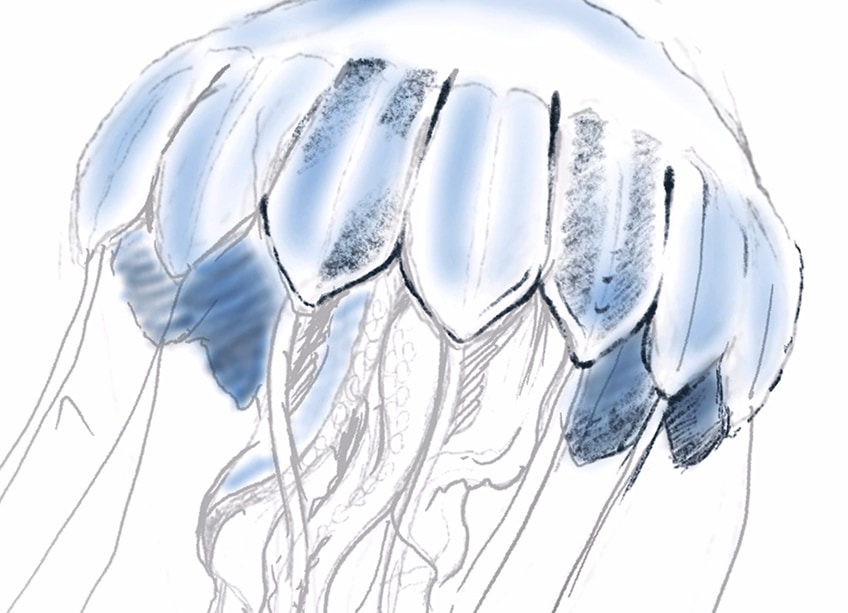
We can also work with a spectrum of blues to bring more definition to the jellyfish outline whilst simultaneously consolidating the color values into the different features. Again, we are still shaping the jellyfish and understanding how the colored details can be used strategically to emphasize the unique form of these various features.

As you start working your way through to the tentacles, we can start bringing a more distinct shape to the jellyfish outline.

Remember that we want to maintain the unraveling quality of the tentacles as they flow from beneath the bell structure of the jellyfish.

We want to capture the tentacles in the center of the bell structure before adding the lace-like atoms around the jellyfish. Take your time with the shape of the tentacles, the arms will be added later as they will sit in the foreground and therefore on top of the tentacles.
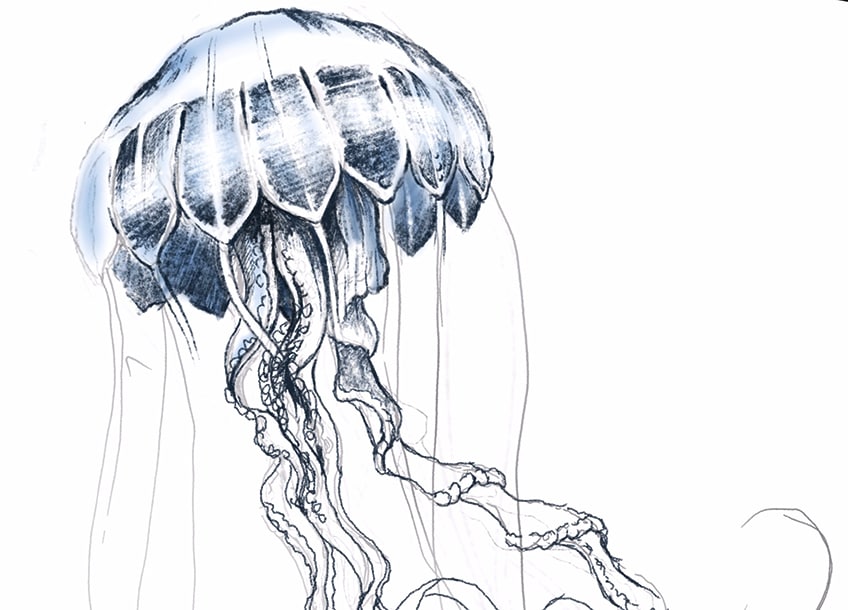
Step 4: Finalizing the Structure of the Jellyfish
We can erase our jellyfish sketch one last time, and then proceed to work in the base layer of a mid-tone blue into the entire jellyfish outline.

This will set the foundational color, on top of which we will work in some darker blues to create some three-dimensionality in the structure of the jellyfish.

We can start working on some linework and shading, working our way from the bell through to the tentacles. Try to spend a good portion of time on each feature of the jellyfish.

When it comes to the tentacles, we want to make sure we create a gradient in the twisting qualities to suggest an unraveling effect. This will show more dimension in the structure as it unravels and becomes more exposed to a light source.

As we do this we can work on adding in these little circular structures along the edges of the ribbon-like structures of the tentacles.

Try to work with a darker blue, as you add these unique details to each tentacle within the jellyfish drawing.

We can then start to work on the lacy arm structures over the tentacles, to emphasize the depth of field between the tentacles in the background and the lacy arms in the foreground.

We want to build up both the tentacles and arms with layers of blue. Working in some lighter and darker tones of blue will emphasize their three-dimensional quality.

Step 5: Final Shadows and Highlights
Once we have sketched and added color to the main aspects of the jellyfish, we can enhance them with some darker linework, shading, and highlights.

This is where to work strategically to darken the shadowed areas and simultaneously add some highlights to the lighter areas.

We can also work in some highlights to the details on the bell of the jellyfish, giving more structure to the finer details such as the warts and ridges. You want to take your time at this point working your way through the entire jellyfish drawing, slowly bringing more shape with darker linework to the tentacles, arms, and bell feature.

Spend a good portion of time on the details present in the foreground, making sure you work your way through the entire structure of the tentacles and the arms.
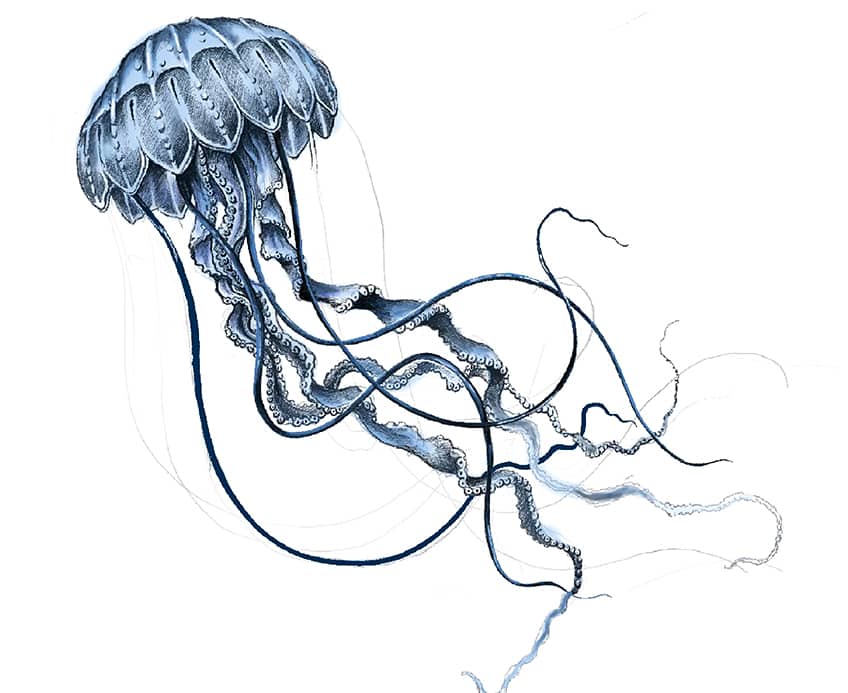
Once we have drawn in the main feature present in the foreground we can start to work in the shading and detail into the features placed in the background.
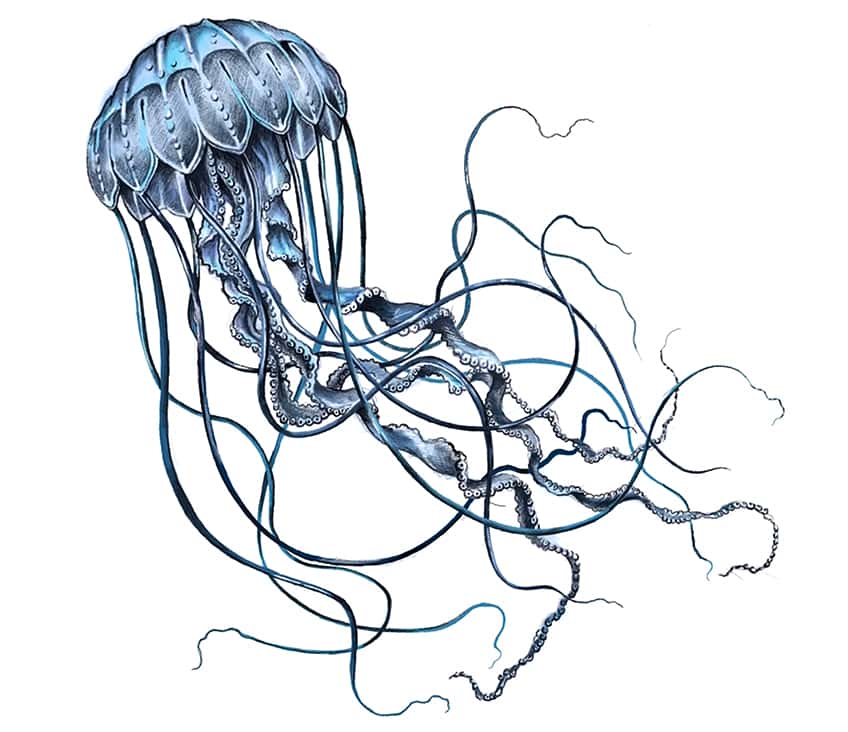
We can’t then take time going through the whole drawing, slowly working in some darker shading and highlights. This is particularly necessary for the area where the bowl-like structure of the bell casts a shadow on the tentacles.

Lastly, you can add a background to further emphasize the deepness of the ocean to contextualize your jellyfish drawing. A simple guide to drawing a jellyfish in a few basic steps.

Tips and Tricks to Remember
- Start with the basic shape of the jellyfish. Try to work out the proportions with a reference image.
- Refine the jellyfish outline. Work with layers of linework, erasing and refining the structure until it is accurate.
- Start with lighter tonal values in color. Always work with building colors from lighter color values to darker color values.
- Take your time with details. Once you have established the shape and colors, you can then build up the details with colored linework and shading.
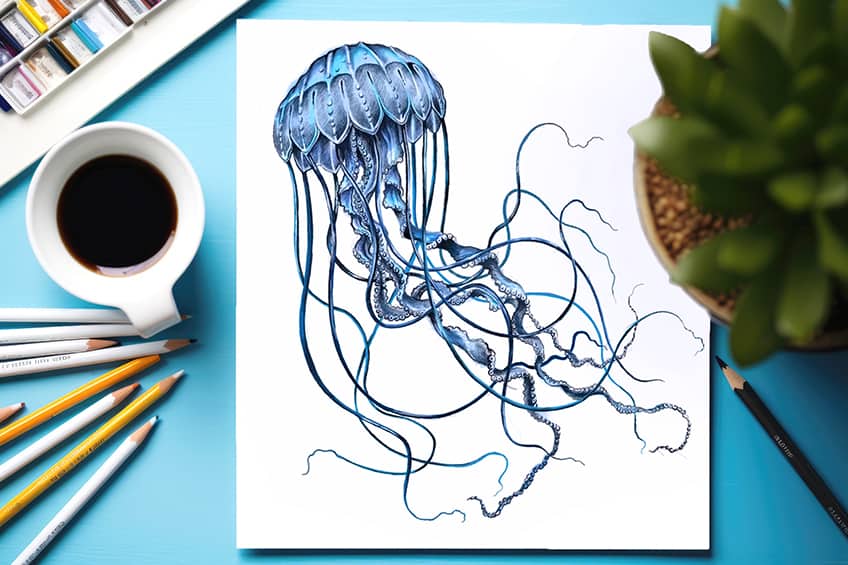
A jellyfish drawing is quite simple once you break up the process into digestible steps. The most important part is to capture the jellyfish outline, which will provide you with parameters for adding details. As we learn how to draw a jellyfish, we see how to utilize a monochromatic coloring process to build up layers for a more realistic representation of textures in our jellyfish drawing.
Frequently Asked Questions
How to Draw the Bell of a Jellyfish?
Naturally, there are various species of jellyfish, and in this particular drawing, we are looking at the Chrysaora jellyfish for inspiration. The Chrysaora has a mushroom-cap-styled hood, with tentacles that flow from beneath it. We can see that it has these ridges that create indentations that move around the bell structure. That being said, we can also be a little creative with our interpretation of these details by drawing them in a simplified way, rather than trying to draw them in a hyperrealistic fashion. As we learn how to draw a jellyfish, we still want to maintain consistency and symmetry throughout the pattern along the bell of the jellyfish. In most cases, the Chrysaora jellyfish is a translucent-looking structure, but we can also play around with the coloration of our jellyfish drawing.
How to Draw the Tentacles of a Jellyfish?
Jellyfish that have the structure of the Chrysaora often have thin-strand tentacles. These tentacles have a ribbon quality to them as they extend from beneath the bell or mushroom cap structure of the jellyfish. The tentacles also have subtle suction cup structures that run along the edges of the tentacles. We can represent these features with small cylindrical shapes that run along the edges of the tentacles. We can also draw in the long shoelace-styled arms that spiral around the tentacles, creating a sense of movement in the jellyfish drawing. Jellyfish are quite abstract, so we can be a little loose with the finer details of these features.
Matthew Matthysen is an educated multidisciplinary artist and illustrator. He successfully completed his art degree at the University of Witwatersrand in South Africa, majoring in art history and contemporary drawing. The focus of his thesis was to explore the philosophical implications of the macro and micro-universe on the human experience. Matthew uses diverse media, such as written and hands-on components, to explore various approaches that are on the border between philosophy and science.
Matthew organized various exhibitions before and during his years as a student and is still passionate about doing so today. He currently works as a freelance artist and writer in various fields. He also has a permanent position at a renowned online gallery (ArtGazette) where he produces various works on commission. As a freelance artist, he creates several series and successfully sells them to galleries and collectors. He loves to use his work and skills in various fields of interest.
Matthew has been creating drawing and painting tutorials since the relaunch in 2020. Through his involvement with artincontext.org, he has been able to deepen his knowledge of various painting mediums. For example, watercolor techniques, calligraphy and lately digital drawing, which is becoming more and more popular.
Learn more about Matthew Matthysen and the Art in Context Team.
Cite this Article
Matthew, Matthysen, “How to Draw a Jellyfish – A Mystical Aquatic Drawing Tutorial.” Art in Context. April 8, 2024. URL: https://artincontext.org/how-to-draw-a-jellyfish/
Matthysen, M. (2024, 8 April). How to Draw a Jellyfish – A Mystical Aquatic Drawing Tutorial. Art in Context. https://artincontext.org/how-to-draw-a-jellyfish/
Matthysen, Matthew. “How to Draw a Jellyfish – A Mystical Aquatic Drawing Tutorial.” Art in Context, April 8, 2024. https://artincontext.org/how-to-draw-a-jellyfish/.



